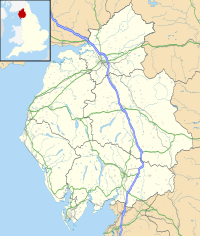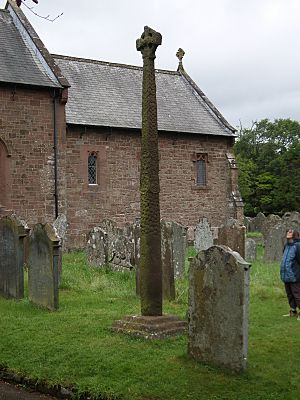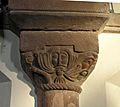St Mary's Church, Gosforth facts for kids
Quick facts for kids St Mary's Church, Gosforth |
|
|---|---|
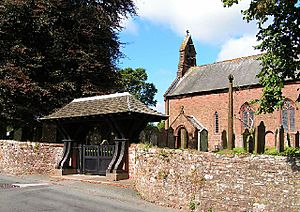
West end of St Mary's Church, Gosforth,
with the Gosforth Cross standing to the right of the porch |
|
| 54°25′09″N 3°25′53″W / 54.4192°N 3.4314°W | |
| OS grid reference | NY 072 036 |
| Location | Gosforth, Cumbria |
| Country | England |
| Denomination | Anglican |
| History | |
| Status | Parish church |
| Architecture | |
| Functional status | Active |
| Heritage designation | Grade I |
| Designated | 9 March 1967 |
| Architect(s) | C. J. Ferguson |
| Architectural type | Church |
| Style | Norman, Gothic Revival |
| Completed | 1899 |
| Specifications | |
| Materials | Stone, slate roofs |
| Administration | |
| Parish | Gosforth |
| Deanery | Calder |
| Archdeaconry | West Cumberland |
| Diocese | Carlisle |
| Province | York |
St Mary's Church is a special old church in the village of Gosforth, England. It's an active Anglican church, meaning people still go there for services. This church is very important because it's a Grade I listed building. This means it's a historic place that needs to be protected. St Mary's is famous for its amazing Viking-age carved stones.
Contents
History of the Church
This church site has been used by Christians since the 8th century. That's a very long time ago! The oldest parts of the church you see today were built in the 12th century.
The church was rebuilt in 1789. However, most of what you see now was built much later. A famous architect named C. J. Ferguson rebuilt almost the entire church between 1896 and 1899.
Church Design and Features
St Mary's Church is built from stone and has a slate roof. It has a main area called a nave, a side area called a north aisle, and a south porch. It also has a chancel (the area around the altar) and north vestries (rooms for clergy).
Outside the Church
The church was mostly rebuilt in the late 1800s in a style called Decorated Gothic. At the west end, there's a small bell tower. The porch has a gabled roof and leads to the south door. To the right of this door, you can see a blocked-up Norman doorway. This doorway used to be on the north side of the church.
Inside the Church
Inside, there's a row of four arches called an arcade on the north side. These arches are pointed and rest on columns with eight-sided tops. The arch leading to the chancel is from the 14th century. It sits on beautifully carved Norman stone tops.
Ancient Viking Stones
In a special spot at the east end of the aisle, you can see two carved Viking hogback stones. These are very rare tomb markers from before the Norman times. They were found under the church's walls during a restoration project in 1896–97. These stones are shaped like houses. The larger one shows humans riding smaller snakes and fighting bigger snakes. The smaller stone shows two armies that might be making a peace agreement.
You can also find other pieces of medieval stones inside the church and in the porch. The small, eight-sided font is from the 19th century.
The Chinese Bell
The church also has a unique Chinese bell from 1839. This bell was taken from a fort in China during a battle in 1841. It was given to the church in 1844.
The Gosforth Fishing Stone
Outside the church, there's a stone slab called the Gosforth fishing stone. Many believe the same artist who carved the famous Gosforth Cross made this stone. It shows the Norse god Thor and the giant Hymir fishing for Jörmungandr, the giant serpent that wraps around the world. Below this scene, a deer is struggling with a serpent. This stone might be a piece of another old cross.
Stained Glass and Organ
Most of the beautiful stained glass windows were made by Ward and Hughes in the late 1800s. The church also has a large pipe organ with two keyboards. It was built by Conacher and Company and later updated in 1984.
Churchyard Features
The Gosforth Cross
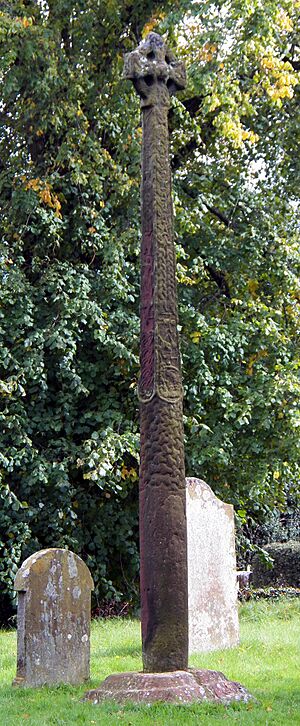
The most important thing in the churchyard is the Gosforth Cross. This is a tall stone cross from the Viking times, made in the early 900s. It's made of sandstone and stands about 4.42 meters (14.5 feet) tall. It's covered with detailed carvings of people and animals, mostly showing stories from Norse mythology. This is the tallest Viking cross in England! It's also a scheduled monument, meaning it's a very important historical site.
Other Crosses and Structures
Another old cross, from around the same time, has been cut down and now serves as a sundial. In the northeast corner of the churchyard, there's a small hut or shed. It was built using leftover stones, including grave covers from the 1200s and pieces of stone with zigzag patterns. This hut is also a listed building. You can also find three old tombstones in the churchyard from the early 1700s, which are also listed as historic.
Gallery
-
Hogback tombs in the church
-
Gosforth cross from the NW
See also
- Bewcastle Cross
- Ruthwell Cross
- Grade I listed churches in Cumbria
- Grade I listed buildings in Cumbria
- Listed buildings in Gosforth, Cumbria


